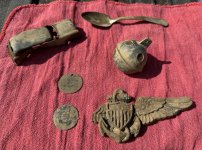CRH in the 50's
This is from Dan Soawrd, in NUmismatic news. I found this section very interesting. Amazing how things have changed. :-)
<< Like many of you, I started collecting when I was around 10. That would be 1957, if you are interested. As a teen-ager, the local bank let me and one of my friends use one of their back rooms to go through bags of pennies, nickels and dimes to fill the holes in our Whitman folders. My friend actually found a G-VG 1916-D Mercury dime during our time at the bank.>>
WOW.
ANyway, just an FYI. Oh, how it must have been back then to search. Shoot - EVERY coin was silver or wheat. ALL of them. LOL. How do you sort if they ALL are keepers? :-)
This is from Dan Soawrd, in NUmismatic news. I found this section very interesting. Amazing how things have changed. :-)
<< Like many of you, I started collecting when I was around 10. That would be 1957, if you are interested. As a teen-ager, the local bank let me and one of my friends use one of their back rooms to go through bags of pennies, nickels and dimes to fill the holes in our Whitman folders. My friend actually found a G-VG 1916-D Mercury dime during our time at the bank.>>
WOW.
ANyway, just an FYI. Oh, how it must have been back then to search. Shoot - EVERY coin was silver or wheat. ALL of them. LOL. How do you sort if they ALL are keepers? :-)
Amazon Forum Fav 👍
Upvote
0






